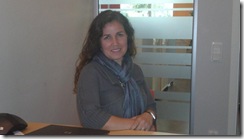Investment in mobile broadband networks is one thing. Monetising the investment through the creation and delivery of services and applications is another thing. Mona Benlaib, Ericsson’s VP and head of Mobile Broadband Engagement Practice in the Middle East and Africa, explains why it is important for operators to also consider a mobile broadband segmentation model 
Mona Benlaib says that mobile broadband business models tailored for the region are critical to ensuring the sustainable uptake of services
According to Pyramid Research there will be 220 million mobile broadband subscribers across the Middle East and Africa by 2015, representing a 28 per cent penetration rate. Relatively low levels of fixed line infrastructure, a young population, and the uptake of smartphones, all point to the MEA region being ripe for significant and successful uptake of mobile broadband services. However, Ericsson’s Mona Benlaib believes that business models tailored for the region are critical in ensuring the sustainable uptake of mobile broadband in the region.
“There really is strong momentum with respect to investment in mobile broadband in the Middle East and Africa,” Benlaib says. “You just have to look at the 3G licences still to be offered in countries such as Pakistan Sudan, and Syria, as well as the 3G networks that are already operational to see how vibrant the mobile broadband infrastructure market is.”
However revenues being generated through non-voice services in the Middle East remain low, and the majority of those data incomes are still largely accounted for by SMS. The challenge now facing operators is to start to consistently generate significant revenue streams via their mobile data networks and ensure that however the value and ecosystem changes in the broadband environment, that their investment in the infrastructure is recognised and rewarded.
“More advanced telecom markets offer good examples as to the additional revenues operators can generate should they implement attractive mobile data plans,” Benlaib says. “In the US for example, ARPU is up to 70 per cent higher from smartphone users than non-smartphone users. And data usage typically rises by about 30 per cent a year after its introduction.”
Services such as mobile money, for example, could prove to become a significant income generator for operators in the region. Already hugely successful in some parts of Africa, mobile money is changing the ways in which people live their lives and earn their livelihoods.
Ericsson has recognised the potential of mobile money and in what could become an industry game-changer, the vendor is launching its international money transfer and payment service via both Internet and mobile phone. Ericsson Money is looking to make a global mobile money solution a reality.
Trials commenced in September 2010 and have steadily grown in scale from about 50 participants and a single currency to a couple of thousand participants and several currencies.
It works by users logging into the site, opening an account and being given an electronic money wallet that they can load with money from pay points in a local store, a post office, a bank or via credit card. They can then send money to any of the six European countries currently participating in the pilot, or to the Philippines, the only non-European country chosen for the trial.
Thus securing devices, reducing price points, and offering transparent and understandable data rates is all part of what is necessary to attract and retain mobile broadband subscribers. Handset manufacturers such as Apple, Research In Motion, and Samsung have been doing a fantastic job of developing high performance, aesthetically pleasing devices, and operators now do believe in the importance of a strong handset portfolio.
According to Ray Hassan, Ericsson’s president of the Gulf region, what is proving to be increasingly important to service providers is not so much time to market, rather it is the timing to market. What he means is that service providers are becoming more astute with their choice and execution of technology and service alternatives; looking to make the right moves at the right time rather than being preoccupied simply with being first to market. 
“Convergence is a reality now, and service providers are looking to harness the benefits of this wider arena,” Hassan says. “Market segmentation is already happening and the desire for operators to really understand their customers is generating an atmosphere of innovation and reinvigoration.”
From the physical products and solutions Ericsson offers, through to its advisory, managed and outsourced offerings, the vendor has cultivated a similarly customer-focussed strategy that assists it in understanding operators pain points and maximising the business opportunities that exist.
“There is a great deal of ambition on both sides of the relationship,” says Hassan. “Operators are ambitious to succeed and grow, and Ericsson is ambitious to deliver the tools to enable the service providers to continue to be successful.”
The increase in data traffic and the exciting applications being created both within the traditional telecom arena as well as from outside of it, is driving the sector through a period of radical change, in which Ericsson would like to be viewed as a stabilising influence.
“We have been cooperating with Internet and software companies outside of the telecom sector for many years, so have been building competence in how these industries intersect the telecom industry and what combined technologies can be harnessed,” Anders Lindblad, president for Ericsson in the Middle East and North Africa, says. “The telecom sector is having to catch up and start moving at the pace of the Internet sector because of the profound influence the Internet is having on it. We realise this and are addressing it,” he adds.
Recently explaining that the world is in the midst of a technology revolution in which IT and telecommunications are coming together to create a networked society, Hans Vestberg, Ericsson president and CEO said: “We see the benefits that are possible when things, as well as people, are connected intelligently. When one person is connected, their life changes; when everything is connected, the world changes. That is the essence of the networked society.”





0 comments ↓
There are no comments yet...Kick things off by filling out the form below.
Leave a Comment